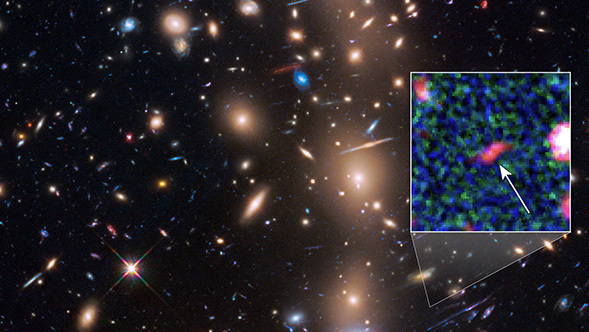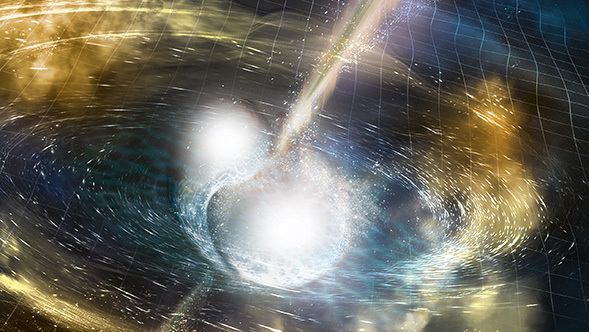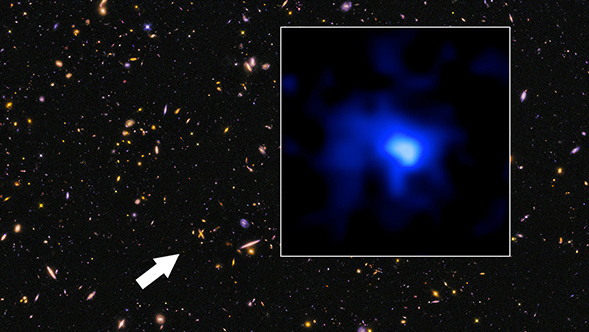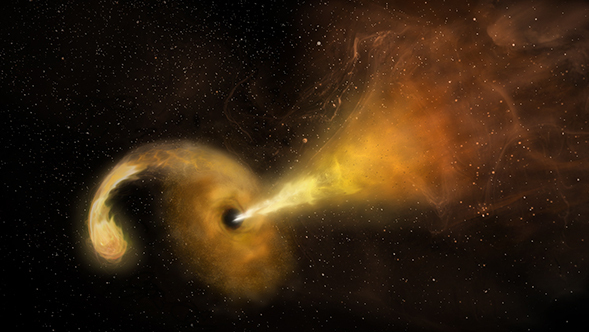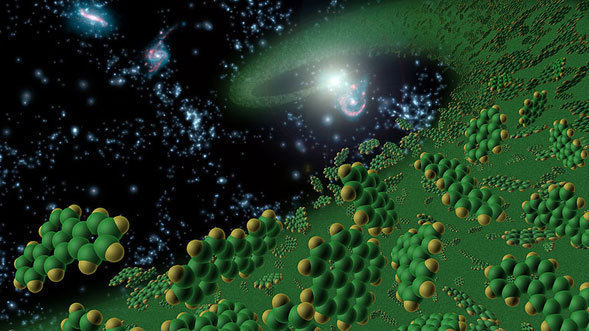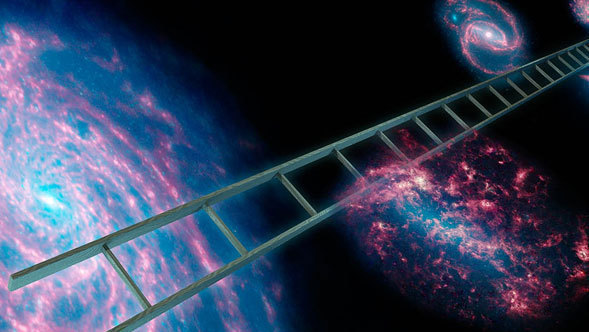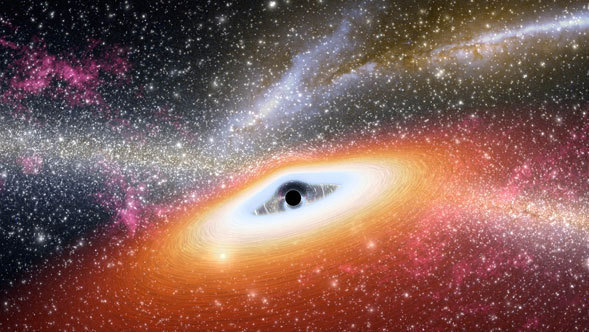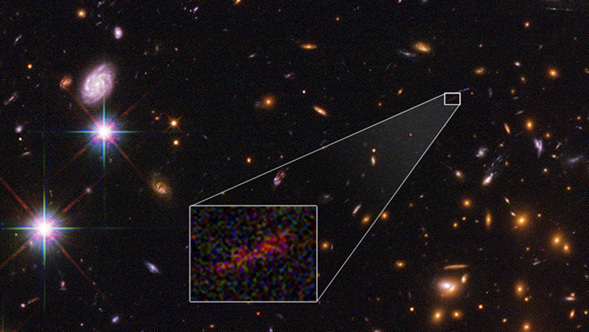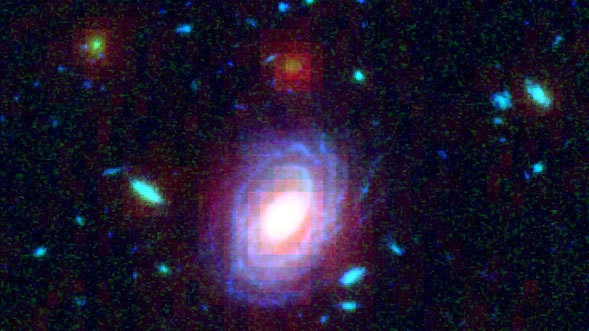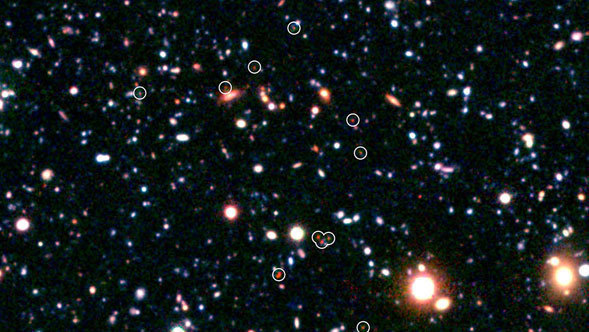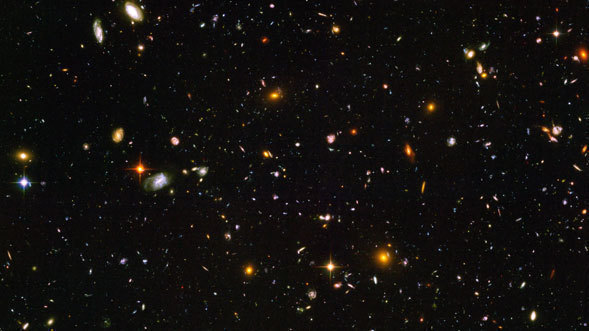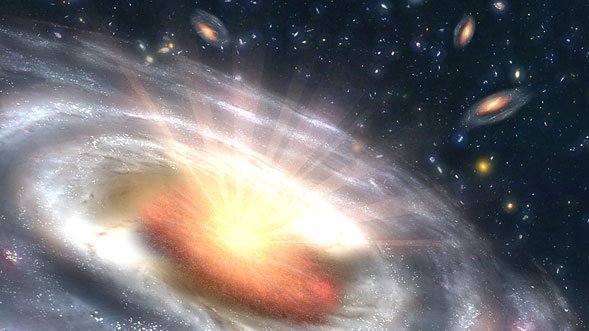In our expanding universe, to look at increasingly distant objects is also like looking back in time to see things as they were billions of years ago. The very expansion of space expands this ancient light, shifting what was once visible to our eyes ever farther into the infrared spectrum. Spitzer was built to give us a way to capture this light from galaxies that formed and grew when the universe was young.
Spitzer has helped to find some of the most distant and ancient galaxies ever detected through their feeble infrared glow. It has also helped us to detect and understand cataclysmic events in distant galaxies connected to the turbulent conditions surrounding the supermassive black holes that lie at their very centers.
Black holes aren't stationary in space; in fact, they can be quite active in their movements. But because they are completely dark and can't be observed directly, they're not easy to study. Scientists have finally figured out the precise timing of a complicated dance between two enormous black holes, revealing hidden details about the physical characteristics of these mysterious cosmic objects.
Astronomers harnessing the combined power of NASA’s Hubble and Spitzer space telescopes have found the faintest object ever seen in the early universe. It existed about 400 million years after the big bang, 13.8 billion years ago.
In just a short amount of time, NASA's Spitzer Space Telescope has bagged thousands of previously unknown dwarf galaxies in a giant cluster of galaxies.
For the first time, NASA scientists have detected light tied to a gravitational-wave event, thanks to two merging neutron stars in the galaxy NGC 4993, located about 130 million light-years from Earth in the constellation Hydra.
An international team of astronomers, led by Yale University and the University of California scientists, pushed back the cosmic frontier of galaxy exploration to a time when the universe was only 5 percent of its present age of 13.8 billion years. The team discovered an exceptionally luminous galaxy more than 13 billion years in the past and determined its exact distance from Earth using the combined data from NASA’s Hubble and Spitzer space telescopes, and the Keck I 10-meter telescope at the W. M. Keck Observatory in Hawaii. These observations confirmed it to be the most distant galaxy currently measured, setting a new record. The galaxy existed so long ago, it appears to be only about 100 million years old.
For the first time, astronomers have directly imaged the formation and expansion of a fast-moving jet of material ejected when the powerful gravity of a supermassive black hole ripped apart a star that wandered too close to the massive monster.
NASA's Spitzer Space Telescope has found the ingredients for life all the way back to a time when the universe was a mere youngster.
Astronomers using NASA's Spitzer Space Telescope have announced one of the most precise measurements yet of the Hubble constant, or the rate at which our universe is stretching apart.
Astronomers have come across what appear to be two of the earliest and most primitive supermassive black holes known. The discovery, based largely on observations from NASA's Spitzer Space Telescope, will provide a better understanding of the roots of our universe, and how the very first black holes, galaxies and stars came to be.
An intensive survey deep into the universe by NASA's Hubble and Spitzer space telescopes has yielded the proverbial needle-in-a-haystack: the farthest galaxy yet seen in an image that has been stretched and amplified by a phenomenon called gravitational lensing.
Two of NASA's Great Observatories, the Spitzer and Hubble Space Telescopes, have teamed up to "weigh" the stars in several distant galaxies. One of these galaxies, among the most distant ever seen, appears to be unusually massive and mature for its place in the young universe.
Astronomers have uncovered a burgeoning galactic metropolis, the most distant known in the early universe. This ancient collection of galaxies presumably grew into a modern galaxy cluster similar to the massive ones seen today.
NASA's Hubble and Spitzer Space Telescopes have joined forces to discover nine of the smallest, faintest, most compact galaxies ever observed in the distant Universe. Blazing with the brilliance of millions of stars, each of the newly discovered galaxies is a hundred to a thousand times smaller than our Milky Way Galaxy.
Astronomers have unmasked hundreds of black holes hiding deep inside dusty galaxies billions of light-years away.
Carnegie Institution of Washington
Balloon-borne Large-Aperture Submillimeter Telescope
A team of astronomers using NASA's Spitzer Space Telescope has discovered a grand total of nearly 300 clusters of galaxies. Almost 100 of these are as far as 8 to 10 billion light-years away, which means they date back to a time when our universe was less than one-third its present age.
University of California, San Diego
It probably comes as no surprise that as powerful as our telescopes are, there are limits to what they can see. As we look farther out into the universe, objects appear smaller and dimmer to us, until at some point, we can't see them as discrete objects any more. But limits are always tantalizing. After all, the most distant objects in the universe are also the youngest (due to the finite speed of light), and therefore desperately interesting to astronomers. Of course, the more distant an object, the fainter it is likely to be. Will we ever be able to see things faint enough to find the very first starlight emitted by the first stars and galaxies? For the time being, we have no telescope with the resolving power and sensitivity to see galaxies that far away. But astronomers have never been good at leaving well enough alone and accepting limitations. Lately, a group of astronomers using the Spitzer Space Telescope have found a method of observing distant galaxies that are, in fact, too faint for Spitzer too see.
Paper trails and DNA tests will not help nearby elliptical galaxies find their galactic ancestors. However, an identification technique recently developed by astronomers using NASA's Spitzer Space Telescope is proving to be very successful in recognizing what could be the predecessors of modern elliptical galaxies.
Astronomers using NASA's Spitzer Space Telescope have conducted a cosmic safari to seek out a rare galactic species. Their specimens -- clusters of galaxies in the very distant universe -- are few and far between, and have hardly ever been detected beyond a distance of 7 billion light-years from Earth.
The components of life may have been under attack in the hostile environments of the universe's first galaxies, say astronomers using NASA's Spitzer Space Telescope.
NASA's Spitzer Space Telescope has observed a rare population of colliding galaxies whose entangled hearts are wrapped in tiny crystals resembling crushed glass.
Scientists using NASA's Spitzer Space Telescope say they have detected light that may be from the earliest objects in the universe. If confirmed, the observation provides a glimpse of an era more than 13 billion years ago when, after the fading embers of the theorized Big Bang gave way to millions of years of pervasive darkness, the universe came alive.
Most of the biggest black holes in the universe have been eating cosmic meals behind closed doors -- until now.

